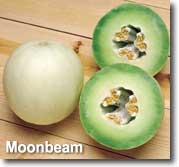|
Powdery Mildew can cause headaches for melon
growers. They know all too well the damage caused by the fungi Erysiphe cichoracearum and
Sphaerotheca fuliginea.
Although there are powdery mildew fungi on many plants, these two
fungi infect only muskmelon, cucumber, squash, pumpkin, gourd, and
watermelon.
When it hits, Powdery
Mildew can cause fruit to be smaller in size, fewer in number, less able to be successfully stored, sunscalded, incompletely ripe, and have a poor
flavor.
Symptoms of Powdery
Mildew:
 This fungus occurs mainly on the leaves, which are the most
susceptible 2 to 3 weeks after unfolding; This fungus occurs mainly on the leaves, which are the most
susceptible 2 to 3 weeks after unfolding;
 A whitish powdery fungal growth is present on the leaves; A whitish powdery fungal growth is present on the leaves;
 Fungal growth often starts on the shaded undersurface of the
crown leaves; Fungal growth often starts on the shaded undersurface of the
crown leaves;
 Severely affected leaves can become dry and brittle, or can
wither and die; Severely affected leaves can become dry and brittle, or can
wither and die;
 Exposed vines and fruit are more prone to sunscald and the vines
may shrivel. Exposed vines and fruit are more prone to sunscald and the vines
may shrivel.
 Horticultural methods can help prevent powdery
mildew. For example, choose a site with good air circulation and low
humidity. Also separate new plantings from old plantings. Use a crop rotation of at least one
year. Control cucurbit weeds and other weeds. Horticultural methods can help prevent powdery
mildew. For example, choose a site with good air circulation and low
humidity. Also separate new plantings from old plantings. Use a crop rotation of at least one
year. Control cucurbit weeds and other weeds.
Another important tool in battling Powdery mildew is planting
disease tolerant varieties such as those offered by Harris Moran Seed
Company.
Recent research done at the Texas A & M Agricultural Research
Station compared nine hybrid honeydew varieties as to powdery mildew rating.
 The
scale was 1 to 10, where 1 was absence of disease symptoms and 10 was complete dieback of
foliage. The
scale was 1 to 10, where 1 was absence of disease symptoms and 10 was complete dieback of
foliage.
Three Harris Moran varieties stood
out.
Morning Ice and HMX 7580 scored a
1.
Moombeam garnered a 3 on the
Powdery Mildew scale. |